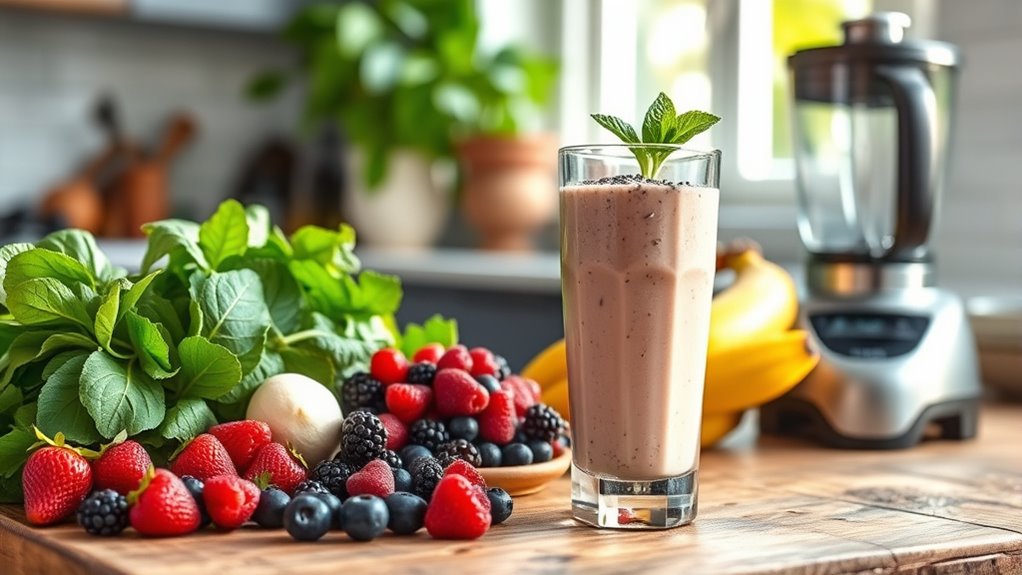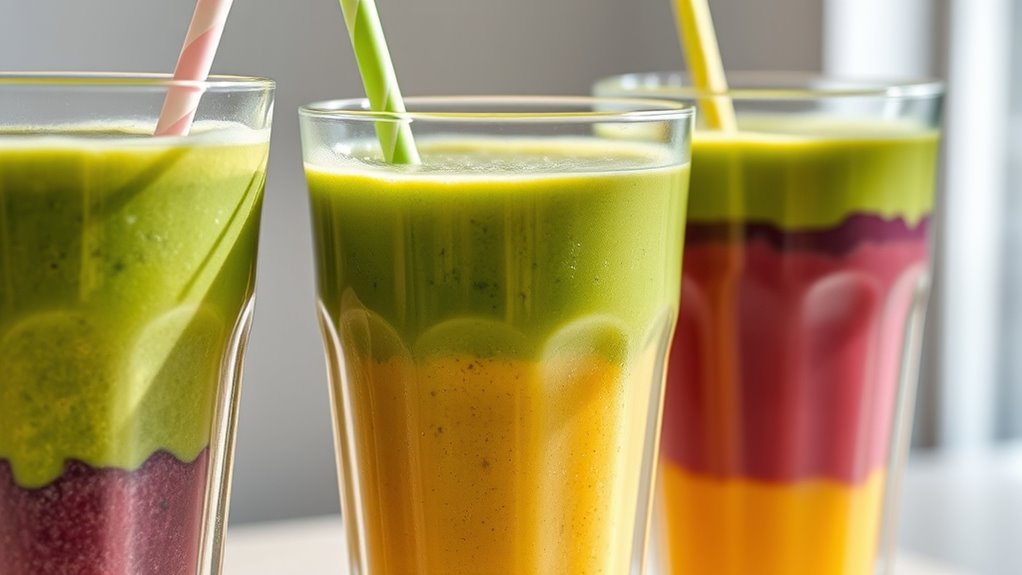To make a healthy smoothie, start with 1 to 1.5 cups of fresh or frozen fruits and 0.5 to 1 cup of vegetables. Add 15 to 20 grams of protein, like yogurt or protein powder, and 1 to 1.5 cups of a liquid base such as water or almond milk. Blend liquids first, then solids, for smooth texture. Keeping natural sweetness and balanced nutrients is key. If you want to refine your blending technique and presentation, there’s more you can explore.
Ingredients and Quantity

Although the specific ingredients may vary depending on your taste and nutritional goals, a balanced smoothie typically includes a combination of fruits, vegetables, a protein source, and a liquid base. Choosing the right fruit combinations helps optimize flavor and nutrient balance, ensuring you get essential vitamins and minerals without excess sugar. Including protein and healthy fats supports sustained energy and fullness.
| Ingredient Type | Suggested Quantity |
|---|---|
| Fruits | 1 to 1.5 cups |
| Vegetables | 0.5 to 1 cup |
| Protein Source | 15 to 20 grams |
| Liquid Base | 1 to 1.5 cups |
This balance allows you to customize your smoothie for freedom in flavor while maintaining nutritional integrity.
Preparations

How you prepare your ingredients can greatly impact the texture and nutritional quality of your smoothie. To maximize the benefits of your smoothie variations, consider these key steps:
Proper ingredient preparation is essential for enhancing both the texture and nutritional quality of your smoothie.
- Wash fruits and vegetables thoroughly to remove contaminants without stripping nutrients.
- Cut ingredients into uniform pieces for even blending, enhancing texture and taste.
- Pre-freeze fruits or use frozen alternatives to achieve a creamy, chilled smoothie without added ice.
- Select the appropriate blending techniques—start slow, then increase speed to fully integrate ingredients without over-heating.
These preparation methods guarantee your smoothie delivers ideal flavor and nutrition. By mastering these simple but essential steps, you gain freedom to experiment with diverse smoothie variations while maintaining a consistent, satisfying texture. Proper preparations set the foundation for a smooth, nutrient-rich blend every time.
How to Prepare

- Choose fresh or frozen fruits, leafy greens, and your preferred liquid base.
- Consider the texture and nutritional goals when selecting ingredients to tailor smoothie variations to your taste and needs.
- Use a high-powered blender for maximum consistency.
- Blend liquids first, then add solids gradually to ensure smooth blending without clumps.
- Measure ingredients accurately to prevent imbalance in flavor and texture.
- Incorporate protein powders, seeds, or nuts last to maintain nutrient integrity.
- Follow these evidence-based preparation methods to maintain control over your smoothie’s quality.
- Experiment with countless variations while guaranteeing a delicious, nutritious result every time.
How to Serve

Where you serve your smoothie can influence both its appeal and enjoyment. Choosing the right presentation styles and glass choices enhances the sensory experience and encourages mindful consumption. Consider these factors:
- Select clear glasses to showcase vibrant colors, stimulating appetite and satisfaction.
- Use tall, narrow glasses for layered smoothies, emphasizing texture and ingredients.
- Serve chilled in frosted glassware to maintain freshness and improve mouthfeel.
- Pair your smoothie with a reusable straw or spoon to support eco-friendly habits and ease of drinking.
Tips

Presenting your smoothie thoughtfully sets the stage for a satisfying experience, but there are additional strategies that can further enhance both flavor and nutrition. When experimenting with smoothie combinations, aim for a balance of macronutrients—incorporate fruits, vegetables, protein, and healthy fats to achieve nutritional balance. Using frozen fruits not only thickens your smoothie but also preserves nutrients. Avoid excessive sweeteners; instead, rely on natural sweetness from fresh or dried fruits. Incorporate leafy greens like spinach or kale for added fiber without overpowering taste. Blending ingredients in stages can improve texture and guarantee even mixing. Finally, adjust liquid amounts to suit your preference, but remember that too much liquid dilutes nutrient density. By applying these tips, you’ll enjoy smoothies that are both delicious and nourishing, supporting your freedom to eat well.
Food Value and Benefit
This smoothie recipe is packed with valuable nutrients that contribute to overall health and wellness. It combines a variety of ingredients rich in vitamins, minerals, and beneficial compounds, making it a nutritious choice for any time of day.
Food Value of the Smoothie:
- Rich in vitamins A, C, K, and several B vitamins
- Contains essential minerals such as iron, calcium, magnesium, and potassium
- High in dietary fiber
- Provides quality protein
- Includes heart-healthy fats and antioxidants
Benefits of Eating This Smoothie:
- Boosts Immunity: Antioxidants and vitamin C from berries and spinach enhance immune system function.
- Supports Skin Health: Vitamins A and E promote healthy, glowing skin.
- Improves Digestion: Fiber from chia seeds and oats aids in smooth digestion and helps maintain bowel regularity.
- Sustains Energy Levels: Balanced macronutrients help maintain stable blood sugar and prolonged energy.
- Enhances Muscle Repair: Protein from Greek yogurt or protein powder supports muscle recovery and satiety.
- Promotes Heart and Brain Health: Healthy fats from avocado and nuts contribute to cardiovascular health and cognitive function.
